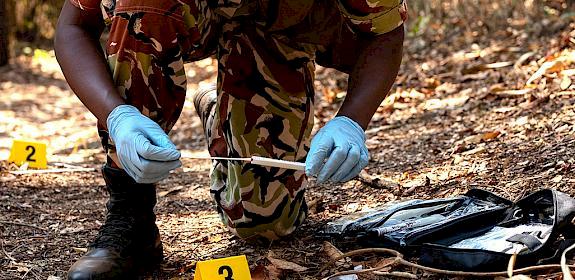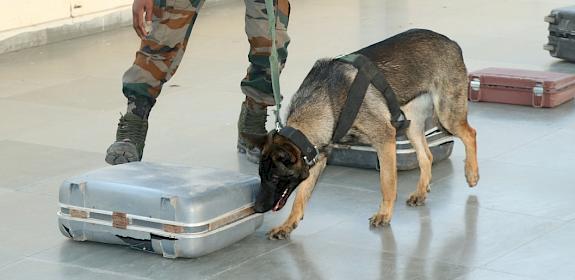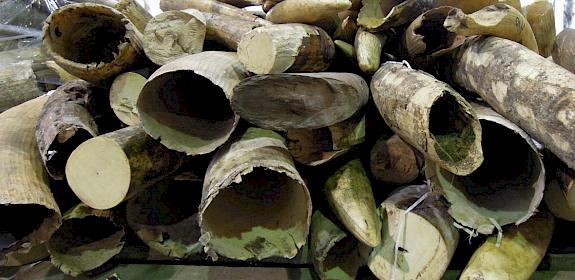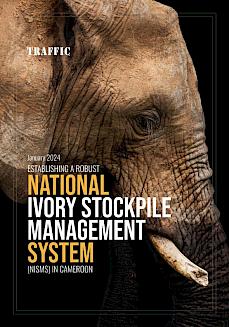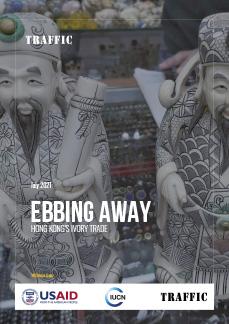
Robust reporting systems are key to tackling illegal ivory trade
After a peak in continental poaching levels of African elephants in 2014-2015, both poaching and illegal trade appear to be showing signs of decreasing. Estimates from the Elephant Trade Information System (ETIS) report to CoP19 (CoP19 Doc. 66.6) show a continued decline in illegal trade. However, the COVID-19 pandemic meant 2020 was an unusual year and may have resulted in lower reporting and law enforcement efforts.
In 2019, the third highest amount of illegal ivory seized by weight was recorded, including three record-setting seizures greater than 7.5 t. When models were run excluding ETIS data for 2020, some trends in the illegal ivory trade of small and medium raw ivory showed a peak in 2019. Moreover, notable seizures have recently been made by authorities, for example, 6 t of raw ivory was seized in July 2022. While awaiting confirmation of seizure details from the Parties involved, reports such as these suggest that law enforcement authorities need to remain vigilant and that continued, detailed monitoring is vital to determine if apparent decreasing trends noted for 2020 are sustainable post-pandemic.
ETIS information is instrumental in monitoring trade patterns and trends globally and plays a critical role in prompting action on the ground. The ETIS report uses the bias-adjusted data from its trend models to identify Parties requiring attention under the National Ivory Action Plan (NIAP) process. While the report outlines the methods to identify Parties as most affected (NIAP Category A), markedly affected (Category B), or affected (Category C) by illegal ivory trade, TRAFFIC welcomes further work being done on better definitions of what the different NIAP categories mean in terms of quantifiable illegal ivory trade characteristics. It is hoped that this work can form part of the proposal in CoP19 Doc. 66.7 to review the NIAP process. Noteworthy is that several Parties which are still participating or have recently exited the NIAP process were identified as requiring attention in the ETIS report due to high illegal ivory trade characteristics. It would therefore be beneficial if part of that review also develops better criteria for NIAP process entry and exit, in consultation with the Monitoring the Illegal Killing of Elephants (MIKE) and ETIS TAG.
TRAFFIC research has long established the relationship between poorly regulated domestic markets and the illegal killing of elephants and trade in elephant products. We, therefore, commend the action of many Parties in their implementation of domestic ivory bans, as called for in Resolution Conf 10.10 (Rev. CoP18) and support the efforts of Parties that wish to make the necessary legislative, regulatory and enforcement measures to close their domestic ivory market, where they feel it is the appropriate course of action to curtail illegal ivory trade. TRAFFIC also supports the renewal of Decisions in CoP19 Doc. 66.1 whereby Parties that have not closed their domestic markets for commercial trade are requested to report to the CITES Secretariat on measures they are taking to ensure that their ivory markets are not contributing to illegal trade. With funding and well-defined objectives, TRAFFIC is also happy to conduct an analysis of ETIS data to inform Parties’ decision-making regarding the legal domestic market as suggested by the EU at SC74.
Stockpiles have often been the source of ivory that has leaked into the illegal market. In the case of countries where ivory stockpiles exist, the maintenance of detailed inventories of ivory stocks can help improve the understanding of the relationship between ivory stockpiles and the illegal trade. Resolution Conf 10.10 (Rev. CoP18) urges Parties to maintain an inventory of government and privately held stocks and to make that information available to MIKE and ETIS. TRAFFIC supports the recommendations made in CoP19 Doc 66.2.1 for countries to step up their efforts in this regard and encourages Parties to always provide sufficient detail and report stocks by individually marked specimens for full transparency, rather than as summarised, aggregated data. TRAFFIC also encourages that these data be consolidated into a database for the most effective use.
At CoP18, TRAFFIC produced an Information Document on ‘Ensuring Effective Stockpile Management’ which sets out the steps needed for adequate management of stockpiles. https://cites.org/eng/imp/ivory_stockpile_mgmt.html Parties are encouraged to use this as guidance when developing their own stockpile management. Efforts to establish a fund accessible to range States upon the non-commercial disposal of ivory stockpiles (as per CoP19 66.2.2) should be considered in the context of the broader need to invest in stockpile management systems.

